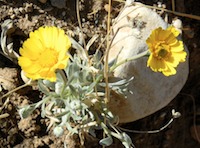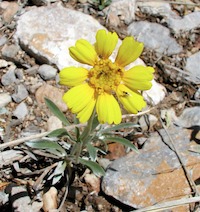Bright, cheery, and playful are all appropriate descriptors for this month’s native plant, a species that has one of the all-time great common names, perky sue. Its happy, yellow flowers appear along the edges of woods, in arroyo beds, as well as a variety of other open areas from early spring through the end of summer as long as the plants receive a little moisture. Perky sue is very likely the first member of the aster family (Asteraceae) to bloom on the Preserve each year. In this unusually dry year, I spotted my first bloom on March 31 and saw them regularly, even though they were somewhat less perky than usual, well into June. I have no doubt that after we get some rain later this summer, perky sue’s yellow smile will reappear on our landscape.
With 135 genera and 628 species in New Mexico, the Asteraceae is far and away our largest plant family. Plants in the genus Tetraneuris are commonly known as rubberweeds and there are six native species in New Mexico. From the Greek words tetra (four) and neuron (nerve), Tetraneuris refers to the four nerves (veins) usually visible in each petal of the ray flowers. The species epithet, argentea, is derived from the Latin word for silver, argentum, and refers to the silvery color of the leaves of Tetraneuris argentea.
Perky sue is a perennial with deep taproots and erect stems that may grow to about 16 inches tall. Its stems tend to be simple, but occasionally may be branched and are covered with long, soft hairs. Most of the leaves are basal with smooth edges and somewhat pitted surfaces. Individual leaves are long and narrow; usually 1-2 inches long (rarely up to 4 inches) and about 1/4 inch wide. Like the stems, leaves are covered with silky hairs that lie flat and produce a silvery coloration. A few similar thin leaves may arise in an alternate pattern along the upright stems.
Each stem typically culminates in a single yellow floral head. The base of a flower head of members of the aster family is called an involucre and consists of overlapping leaf-like structures called phyllaries, the characteristics of which are often important distinguishing between species in this large family. The phyllaries of perky sue have long, soft hairs and are organized into two or three rows forming a bell-shaped involucre. Each floral head produces 8-14 ray flowers that bear female, but no male sex organs. The outer petal of a ray flower is about 1/2 inch long, with four nerves and flattened, notched ends. The ray flowers surround up to 100 or so tightly packed yellow disk flowers. Each disk flower contains both male and female sex organs (stamens and pistils).
The Navajo Nation has long been captivated by perky sue, designating it as a “life medicine.” Lotions and other medicines prepared from this plant have been used to treat eczema, heartburn, and a variety of injuries including “coyote infection.” In addition Navajos believed perky sue was capable of providing protection from witches. Although I am not able to vouch for such claims, I do know that this happy wildflower never ceases to bring a smile to my face. Despite its delicate appearance, perky sue is quite hardy and tolerates full sun, rocky areas, and poor soils. Once established in a wildflower garden it will spread via its root system to form natural clumps. Whether you use this little beauty to perk up a drab spot in your yard or to brighten your spirits as you roam the Preserve, it is definitely worth the effort to become familiar with this pleasant native wildflower.
© Jerry Melaragno 2011
Downloadable pdf of this essay here.


